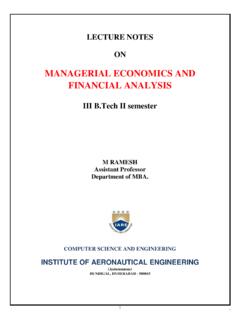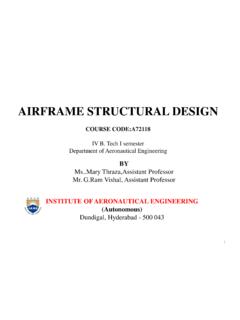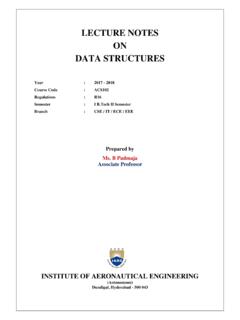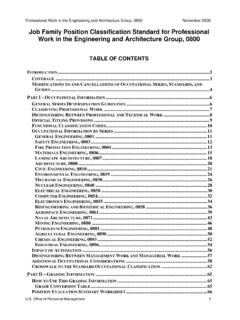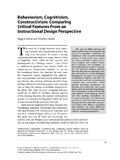Transcription of LECTURE NOTES ON MANAGEMENT SCIENCE
1 LECTURE NOTES ON MANAGEMENT SCIENCE Department of CIVIL engineering INSTITUTE OF AERONAUTICAL engineering Dundigal 500 043, Hyderabad CONTENTS Unit I: Introduction to MANAGEMENT : Concepts of MANAGEMENT and organization- nature, importance and Functions of MANAGEMENT , Systems Approach to MANAGEMENT - Taylor's Scientific MANAGEMENT Theory- Fayal's Principles of MANAGEMENT - Maslow's theory of Hierarchy of Human Needs- Douglas McGregor's Theory X and Theory Y - Hertzberg Two Factor Theory of Motivation - Leadership Styles, Social responsibilities of MANAGEMENT .
2 UNIT -II: Designing Organization: Designing Organizational Structures: Basic concepts related to Organization - Departmentation and Decentralization, Types and Evaluation of mechanistic and organic structures of organization and suitability. line ,line and staff organization, function ,committee, matrix, virtual, cellular, team organization. boundary less organization, inverted pyramid structure , lean and flat organization UNIT - III: Operations and Marketing MANAGEMENT : Principles and Types of Plant Layout-Methods of Production(Job, batch and Mass Production), W ork Study - Basic procedure involved in Method Study and W ork Measurement - Business Process Reengineering(BPR) - Statistical Quality Control.
3 Control charts for Variables and Attributes (simple Problems) and Acceptance Sampling, TQM, Six Sigma, Deming's contribution to quality, Objectives of Inventory control, EOQ, ABC Analysis, Purchase Procedure, Stores MANAGEMENT and Store Records - JIT System, Supply Chain MANAGEMENT , Functions of Marketing, Marketing Mix, and Marketing Strategies based on Prodcut Life Cycle, Channels of distribution. UNIT IV: A) MATERIAL MANAGEMENT : Objective, Need For Inventory Control, EOQ, ABC Analysis, purchase procedure , store MANAGEMENT and store records- supply chain MANAGEMENT B) MARKETING: Function of marketing, marketing mix, marketing strategies based on product life cycle, channels of distribution UNIT - V: Human Resources MANAGEMENT (HRM): Concepts of HRM, HRD and Personnel MANAGEMENT and Industrial Relations (PMIR), HRM vs.
4 PMIR, Basic functions of HR Manager: Manpower planning, Recruitment, Selection, Training and Development, Placement, W age and Salary Administration, Promotion, Transfer, Separation, Performance Appraisal, Grievance Handling and W elfare Administration, Job Evaluation and Merit Rating - Capability Maturity Model (CMM) Levels - Performance MANAGEMENT System. UNIT - VI: Project MANAGEMENT (PERT/ CPM): Network Analysis, Programme Evaluation and Review Technique (PERT), Critical Path Method (CPM), Identifying critical path, Probability of Completing the project within given time, Project Cost Analysis, Project Crashing (simple problems).
5 UNIT - VII: Strategic MANAGEMENT : Mission, Goals, Objectives, Policy, Strategy, Programmer, Elements of Corporate Planning Process, Environmental Scanning, Value Chain Analysis, SW OT Analysis, Steps in Strategy Formulation and Implementation, Generic Strategy alternatives. UNIT-1 INTRODUCTION TO MANAGEMENT Introduction to MANAGEMENT : When human being started group activities for the attainment of same common objectives whenever a group is formed and a group activity is organized to achieve certain common objectives MANAGEMENT is needed to direct, co-ordinate and integrate the individual activities of a group and secure teams work to accomplish organizational objectives.
6 The objectives of all business are attained by utilizing the scare resources like men, materials, machines, money etc. In process of MANAGEMENT , a manage uses human skills, material resources and scientific methods to perform all the activities leading to the achievement of goods. Definition: MANAGEMENT is knowing exactly what you want men to do and then seeing that they do it the best and cheapest ways . MANAGEMENT is defined as the creation and maintenance of an internal environment in an enterprise where individuals working together in groups, can perform efficiently and effectively towards the attainment of group goals.
7 __Koontz and O Donell Nature of MANAGEMENT : The study and application of MANAGEMENT techniques in managing the affairs of the organization have changed its nature over the period of time. Multidisciplinary: MANAGEMENT is basically multidisciplinary. This implies that, although MANAGEMENT has been developed as a separate discipline, it draws knowledge and concepts from various disciplines. It draws freely ideas and concepts from such disciplines as psychology, sociology, anthropology, economics, ecology, statistics, operations research, etc.
8 MANAGEMENT integrates the ideas and concepts taken from these disciplines and present newer concepts which can be put into practice for managing the organization. Dynamic nature of principle: Based on integration and supported by practical evidences, MANAGEMENT has formed certain principles. However, these principles are flexible in nature and change with the changes in the environment in which an organization exists. Relative, not absolute principles: MANAGEMENT principle are relative, not absolute, and they should be applied according to the need of the organization.
9 Each organization may be different from others. The difference may exist because of time, place, socio-cultural factors, etc. MANAGEMENT SCIENCE or Art: There is a controversy whether MANAGEMENT is SCIENCE or art. However, MANAGEMENT is both a SCIENCE and art. MANAGEMENT as profession: MANAGEMENT has been regarded as profession by many while many have suggested that it has not achieved the status of a profession. Characteristics of MANAGEMENT : Setting goals for organizations: Goals differ from organization to organization in business, the basic economic goal is to earn maximum profit, while in service organization like hospital and educational institution for the basic goal is to provide better service and better education.
10 Awareness of opportunities and resources: MANAGEMENT have awareness of opportunities and resources like men, materials, money which assembles and integrates by MANAGEMENT . MANAGEMENT is transformation process: MANAGEMENT is a transformation process consisting of planning, organizing, staffing, directing and controlling. MANAGEMENT is universal: The principles and techniques of MANAGEMENT are universally applicable to all group activities performed at any level of organization. System of authority: System of authority means a hierarchy of command and control.
